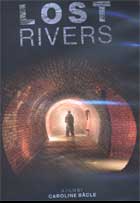
Lost Rivers 2012
Distributed by Icarus Films, 32 Court St., 21st Floor, Brooklyn, NY 11201; 800-876-1710
Produced by Katarina Soukup
Directed by Caroline Bâcle
DVD, color, 72 min.
Jr. High - General Adult
Ecology, Urban Areas, Water
Date Entered: 04/08/2014
Reviewed by Cliff Glaviano, formerly with Bowling Green State University Libraries, Bowling Green, OHHistorically, cities were built near water, often around the confluence of rivers on navigable tributaries to the oceans. As nations industrialized and city populations grew, once free-flowing streams became stinking open sewers, breeding grounds for pests and disease. To contain these streams, control disease, and allow for storm drainage, engineers channelized the flows, forced them underground, and built their cities above these now lost rivers. Internationally, adventurous urban spelunkers known as “drainers” have taken to charting and exploring (sometimes illegally) the streams forced belowground and incorporated into sewer systems in major cities in Europe and North America.
Forcing the rivers underground has not always been successful. In Seoul, a major highway was demolished, an urban stream uncovered, and a park with flowing waters created. In Toronto, rainstorms overwhelm the system forcing overflows of untreated sewage into Lake Ontario, temporarily closing local beaches. An alternative to Toronto’s storm water problem was proposed that included holding ponds along the above ground, historical course of Garrison Creek similar to the wetland/holding pond system created for London following the devastating English floods of 2009. In Brescia, Italy, “drainers” now give architectural tours of their underground rivers highlighting the Roman bridges and ductwork buried along with their lost river. In Yonkers, NY, re-daylighting the Saw Mill River to create green space similar to that created in Seoul should revitalize downtown Yonkers’ economy.
This video is highly recommended. The underground scenes shot in the sewers of Montreal, Toronto, the New York City area, London, and Brescia are fascinatingly beautiful as well as downright spooky. Viewers will understand what motivates the “drainers” to follow their exploring passions. Similar care is taken to document the magnitude of daylighting the rivers in Seoul and Yonkers and the disruptions to local economies while projects are in progress. Likewise the enormity of scale of creating the London holding pond system and a similar proposed system for Toronto which was not adopted due to cost estimates and questions of engineering feasibility. This film is a wonderful handling of complex problems and diverse points of view that should encourage the viewer’s further exploration of urban ecology.